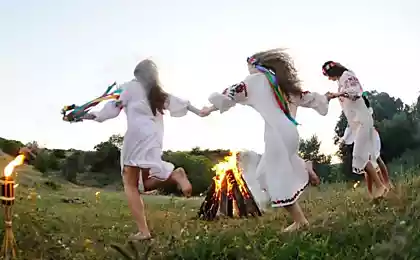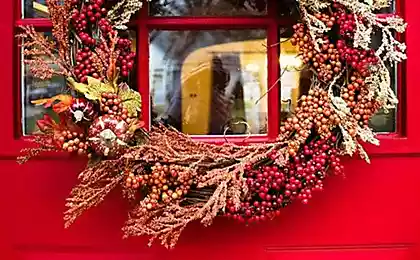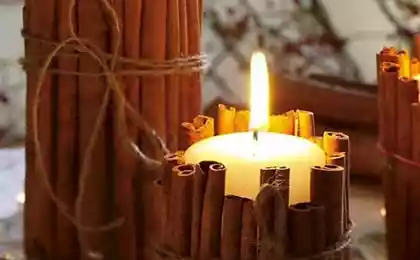4411
Crowns and monarchs
Crown - in Latin means wreath.
This term is derived from a wreath, which in ancient Greece and then in Rome set up on the head especially distinguished citizens.
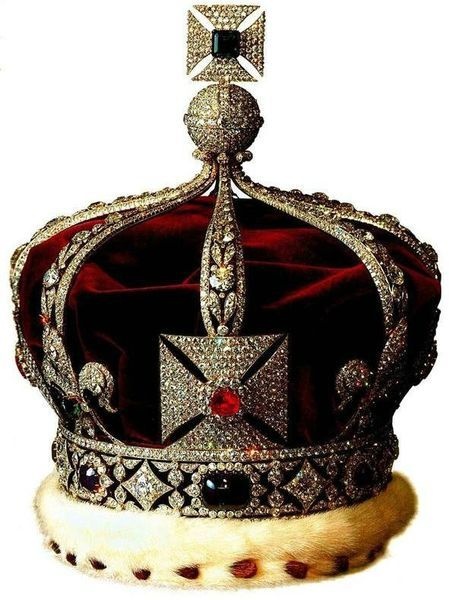
Almost equal to the gods
The winner of the Olympic Games received a wreath of olive branches, and poetry competitions in honor of Apollo - bay (hence the word "winner"). Oak wreath was a sign of special protection of Zeus, his generals and rulers were awarded. In the second half of the V century BC. e., when finished Greco-Persian Wars, they won the Greek cities quickly began to prosper and have the opportunity to make distinctions, with which were wreaths of "eternal" material - gold. Massive wreath with golden oak leaves was found during excavations presumably royal tombs in the capital of ancient Macedonia, the city of Ega. It is believed that it belonged to Philip II, father of Alexander the Great. The Greeks believed that the dead for a virtuous life, like the heroes can get into the society of the gods. Therefore the grave often put a wreath, who testified about the merits of the deceased, as well as his victory in the battle, which the Greeks likened life.
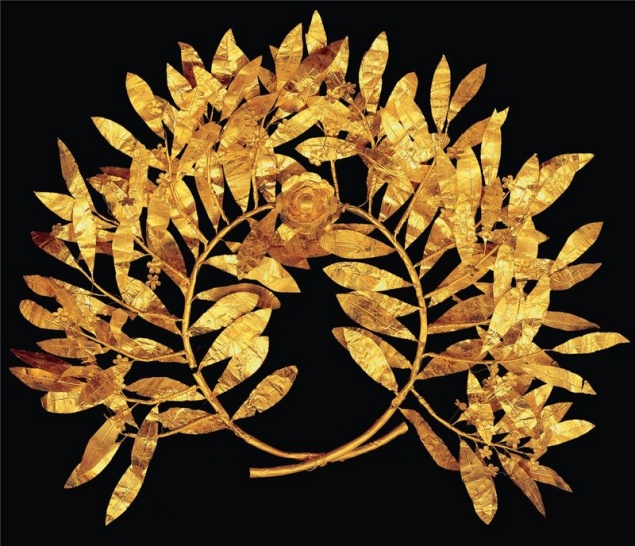
Ancient Greece II century BC Golden Wreath
Five of the world tree
Very rarely, archaeologists can not locate the burial, which would not be managed for a while robbers. One of the rarest of exceptions - seven tombs excavated in 1979 by a Soviet expedition Victor Sarianidi in Afghanistan on a hill Tilla Tepe. The richest of them belonged to a girl of noble birth. The tomb was found a lot of gold objects: a scepter, necklace, bracelets, coins. The girl's head was decorated with a golden crown, five teeth, which are in the form of trees with flowers and birds. They seem to refer back to the ancient Aryan myth of the five World Tree - four on the sides of light and one in the middle. The girl apparently belonged to the nomadic Yuezhi people, who in the II century BC. e. was supplanted by the Huns from the north-west frontier of China to Central Asia. In the I century on the territory of the Greco-Bactrian there "five lands" Yuezhi, who later formed the Kushan state. Maybe she was the queen of one of the "five possessions».

Central Asia I century BC Crown Yuezhi
From Charlemagne to Napoleon
Was made when the so-called iron crown Longobardians unknown, most likely between V and VIII eyelids. One thing is for sure - after the Lombards conquered northern part of Italy, all their kings were crowned exactly it. Charlemagne, capturing the kingdom of the Lombards, also assumed the iron crown. In fact, it gold with precious stones and cloisonne enamel, iron in it only the inner hoop. According to legend, he forged from a nail - one of those that was pierced on the cross, the Savior's body. However, according to modern scholars, hoop nothing to do with the sacred relics has not, it simply reinforced the structure, since gold is too soft metal. None of the crown in the world served by purpose as long as the crown of the Lombards. Starting from the X century it crowned emperor of the Holy Roman Empire, which includes Northern Italy. In 1805, banished from Italy imperial Habsburg dynasty, she wanted to be crowned Napoleon Bonaparte. Putting on the iron crown, he declared: "God gave it to me - and woe to anyone who touches it." Now the crown is stored in the main cathedral of the Italian city of Monza.

Italy V-VIII century iron crown of the Lombards
Gift Dame
Tradition states that in 1001 during the coronation of the first Hungarian king, Saint Stephen (Stephen) I, granted him by Pope raised crown on himself and presented it to the Virgin Mary, concluding thus the divine contract between her and the crown. From that moment Our Lady was not only a patron saint, and the Queen of Hungary. In fact, the crown was made in the XII century by order of King Béla III, who was educated at Constantinople yard. Its top is decorated with an icon of Christ Pantocrator, it is inserted into a cross, which until the XVII century was a direct, but then as a result of some manipulation appeared bent. On rims are the images of saints and portraits of the Byzantine emperors. Crown of St. Stephen's was, so to speak, more important than the king himself. In particular, in most other countries, the heir became monarch immediately after the death of the ruler and the coronation was a symbolic act, in Hungary, he received power only after hoisting upon his brow the crown of St. Stephen. But the king could touch the relics, only two - the major-domo and Archbishop Esztergom. Crown is a symbol of supreme power in Hungary today, however, is no longer the royal and state. In 2000, she took pride of place in the building of the Hungarian parliament.

Byzantium - Hungary XII century St. Stephen's Crown
Antikonditsionny crown
In 1724, for the coronation of his wife Catherine I, Peter the Great, he was crowned tsar even Cap of Monomakh, the master ordered the Russian crown. She subsequently crowned and Peter II. For guest of Courland to the Russian throne of Anna Ivanovna in 1730 ordered a new crown, which made the German master Wilhelm Gottlieb Dunkel. The basis of the gold and silver he decorated two and a half thousand gems - diamonds and rubies, most of which has been removed from the crown of Catherine I. Since it was also filmed and huge dark red tourmaline, once bought from the Chinese emperor - his Dunkel posted directly beneath a diamond cross, crowning the crown. Crown Anna Ivanovna, where she was crowned April 28, 1730, has become one of the symbols of the Russian autocracy. The fact is that in the future queen of Courland signed "condition" significantly limits its power. But in Moscow, taking advantage of differences that have arisen among the nobility, she tore the paper and began to rule autocratically. It is possible that it is in the memory of this episode, not only for the grace, that this crown in the XIX century was placed on the coat of arms attached to the Russian Kingdom of Poland. At present, the crown is kept in the Armory.

St. Petersburg 1730 Crown Anna Ivanovna
Regalia economy class
For 200 years, until the Napoleonic wars, the Netherlands remained a republic, one of the few in Europe. But when Bonaparte was over, the Dutch decided that only a strong government will be able to save the country from the new conquerors. And in 1815, the Netherlands became an absolute monarchy. King William I took the throne of Orange, son of the last ruler of the election of the country. But he was crowned and has not been - the ceremony, claiming absolute power, traditionally called Netherlanders have allergies. Crowned in 1840, was the son of William I - Wilhelm II. Much to spend on her practical Dutch did not. It is not made of gold, but mostly of gilded silver with inlays of silk, diamonds and pearls on her fake, that does not prevent the crown serve as a symbol of the monarchy in the country. However, upon her head, no one put on. When the king and parliament take an oath to the crown resting on a special table. All the rest of the time she does not leave the King's Fund.

Amsterdam 1840 The Netherlands Crown
Exaltation wife
In 1967, 48-year-old Shah of Iran Mohammad Reza Pahlavi, stay on the throne for 26 years, decided to finally be crowned with his beloved young wife, 29-year-old Farah, who bore him two sons and a daughter. Actually, for the sake of it all and has been started. Especially for wife Shah returned into use ancient title of Empress - Shakhbanov who wore no wife of the Shah from the VII century. Farah thus officially became the second person in the state, and if the Shah will not be able to perform their duties, it is up to adulthood heir received full authority. Crown was ordered to Shakhbanov Parisian jeweler Pierre ARPEL. Since the export of Iranian shah jewelry was forbidden, ARPEL has made 20 trips between Paris and Tehran before the order was made.
Crown of white gold decorated with 38 emeralds, 34 rubies, 105 pearls and 1500 diamonds, the largest weighing 90 carats.
Unheard-of luxury coronation took place on 26 October 1967. Mohammad Reza Shah's crown put on yourself, and then put the crown on the head of his wife. Journalists wrote that it's all very reminiscent of the coronation of Napoleon and Josephine, and predicted the Iranian monarch same end. After 12 years of Pahlavi had to flee the country.

Tehran 1967 Crown Lights Pahlavi
And a few more crowns




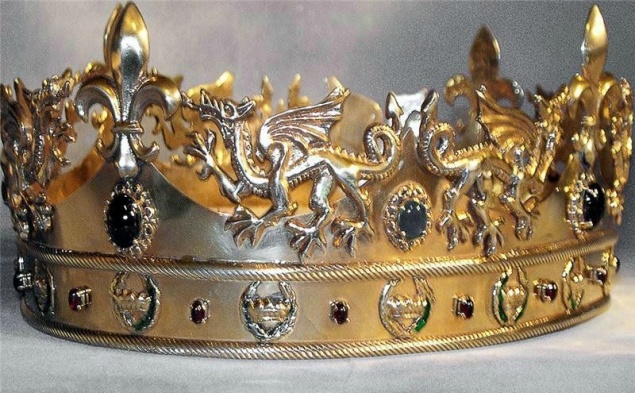




Source: www.liveinternet.ru
This term is derived from a wreath, which in ancient Greece and then in Rome set up on the head especially distinguished citizens.

Almost equal to the gods
The winner of the Olympic Games received a wreath of olive branches, and poetry competitions in honor of Apollo - bay (hence the word "winner"). Oak wreath was a sign of special protection of Zeus, his generals and rulers were awarded. In the second half of the V century BC. e., when finished Greco-Persian Wars, they won the Greek cities quickly began to prosper and have the opportunity to make distinctions, with which were wreaths of "eternal" material - gold. Massive wreath with golden oak leaves was found during excavations presumably royal tombs in the capital of ancient Macedonia, the city of Ega. It is believed that it belonged to Philip II, father of Alexander the Great. The Greeks believed that the dead for a virtuous life, like the heroes can get into the society of the gods. Therefore the grave often put a wreath, who testified about the merits of the deceased, as well as his victory in the battle, which the Greeks likened life.

Ancient Greece II century BC Golden Wreath
Five of the world tree
Very rarely, archaeologists can not locate the burial, which would not be managed for a while robbers. One of the rarest of exceptions - seven tombs excavated in 1979 by a Soviet expedition Victor Sarianidi in Afghanistan on a hill Tilla Tepe. The richest of them belonged to a girl of noble birth. The tomb was found a lot of gold objects: a scepter, necklace, bracelets, coins. The girl's head was decorated with a golden crown, five teeth, which are in the form of trees with flowers and birds. They seem to refer back to the ancient Aryan myth of the five World Tree - four on the sides of light and one in the middle. The girl apparently belonged to the nomadic Yuezhi people, who in the II century BC. e. was supplanted by the Huns from the north-west frontier of China to Central Asia. In the I century on the territory of the Greco-Bactrian there "five lands" Yuezhi, who later formed the Kushan state. Maybe she was the queen of one of the "five possessions».

Central Asia I century BC Crown Yuezhi
From Charlemagne to Napoleon
Was made when the so-called iron crown Longobardians unknown, most likely between V and VIII eyelids. One thing is for sure - after the Lombards conquered northern part of Italy, all their kings were crowned exactly it. Charlemagne, capturing the kingdom of the Lombards, also assumed the iron crown. In fact, it gold with precious stones and cloisonne enamel, iron in it only the inner hoop. According to legend, he forged from a nail - one of those that was pierced on the cross, the Savior's body. However, according to modern scholars, hoop nothing to do with the sacred relics has not, it simply reinforced the structure, since gold is too soft metal. None of the crown in the world served by purpose as long as the crown of the Lombards. Starting from the X century it crowned emperor of the Holy Roman Empire, which includes Northern Italy. In 1805, banished from Italy imperial Habsburg dynasty, she wanted to be crowned Napoleon Bonaparte. Putting on the iron crown, he declared: "God gave it to me - and woe to anyone who touches it." Now the crown is stored in the main cathedral of the Italian city of Monza.

Italy V-VIII century iron crown of the Lombards
Gift Dame
Tradition states that in 1001 during the coronation of the first Hungarian king, Saint Stephen (Stephen) I, granted him by Pope raised crown on himself and presented it to the Virgin Mary, concluding thus the divine contract between her and the crown. From that moment Our Lady was not only a patron saint, and the Queen of Hungary. In fact, the crown was made in the XII century by order of King Béla III, who was educated at Constantinople yard. Its top is decorated with an icon of Christ Pantocrator, it is inserted into a cross, which until the XVII century was a direct, but then as a result of some manipulation appeared bent. On rims are the images of saints and portraits of the Byzantine emperors. Crown of St. Stephen's was, so to speak, more important than the king himself. In particular, in most other countries, the heir became monarch immediately after the death of the ruler and the coronation was a symbolic act, in Hungary, he received power only after hoisting upon his brow the crown of St. Stephen. But the king could touch the relics, only two - the major-domo and Archbishop Esztergom. Crown is a symbol of supreme power in Hungary today, however, is no longer the royal and state. In 2000, she took pride of place in the building of the Hungarian parliament.

Byzantium - Hungary XII century St. Stephen's Crown
Antikonditsionny crown
In 1724, for the coronation of his wife Catherine I, Peter the Great, he was crowned tsar even Cap of Monomakh, the master ordered the Russian crown. She subsequently crowned and Peter II. For guest of Courland to the Russian throne of Anna Ivanovna in 1730 ordered a new crown, which made the German master Wilhelm Gottlieb Dunkel. The basis of the gold and silver he decorated two and a half thousand gems - diamonds and rubies, most of which has been removed from the crown of Catherine I. Since it was also filmed and huge dark red tourmaline, once bought from the Chinese emperor - his Dunkel posted directly beneath a diamond cross, crowning the crown. Crown Anna Ivanovna, where she was crowned April 28, 1730, has become one of the symbols of the Russian autocracy. The fact is that in the future queen of Courland signed "condition" significantly limits its power. But in Moscow, taking advantage of differences that have arisen among the nobility, she tore the paper and began to rule autocratically. It is possible that it is in the memory of this episode, not only for the grace, that this crown in the XIX century was placed on the coat of arms attached to the Russian Kingdom of Poland. At present, the crown is kept in the Armory.

St. Petersburg 1730 Crown Anna Ivanovna
Regalia economy class
For 200 years, until the Napoleonic wars, the Netherlands remained a republic, one of the few in Europe. But when Bonaparte was over, the Dutch decided that only a strong government will be able to save the country from the new conquerors. And in 1815, the Netherlands became an absolute monarchy. King William I took the throne of Orange, son of the last ruler of the election of the country. But he was crowned and has not been - the ceremony, claiming absolute power, traditionally called Netherlanders have allergies. Crowned in 1840, was the son of William I - Wilhelm II. Much to spend on her practical Dutch did not. It is not made of gold, but mostly of gilded silver with inlays of silk, diamonds and pearls on her fake, that does not prevent the crown serve as a symbol of the monarchy in the country. However, upon her head, no one put on. When the king and parliament take an oath to the crown resting on a special table. All the rest of the time she does not leave the King's Fund.

Amsterdam 1840 The Netherlands Crown
Exaltation wife
In 1967, 48-year-old Shah of Iran Mohammad Reza Pahlavi, stay on the throne for 26 years, decided to finally be crowned with his beloved young wife, 29-year-old Farah, who bore him two sons and a daughter. Actually, for the sake of it all and has been started. Especially for wife Shah returned into use ancient title of Empress - Shakhbanov who wore no wife of the Shah from the VII century. Farah thus officially became the second person in the state, and if the Shah will not be able to perform their duties, it is up to adulthood heir received full authority. Crown was ordered to Shakhbanov Parisian jeweler Pierre ARPEL. Since the export of Iranian shah jewelry was forbidden, ARPEL has made 20 trips between Paris and Tehran before the order was made.
Crown of white gold decorated with 38 emeralds, 34 rubies, 105 pearls and 1500 diamonds, the largest weighing 90 carats.
Unheard-of luxury coronation took place on 26 October 1967. Mohammad Reza Shah's crown put on yourself, and then put the crown on the head of his wife. Journalists wrote that it's all very reminiscent of the coronation of Napoleon and Josephine, and predicted the Iranian monarch same end. After 12 years of Pahlavi had to flee the country.

Tehran 1967 Crown Lights Pahlavi
And a few more crowns









Source: www.liveinternet.ru


